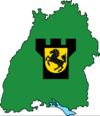Hohenheim Castle
| Hohenheim Castle | |
|---|---|
| Schloss Hohenheim | |
 | |
 Schloss Hohenheim Location in Baden-Württemberg | |
| General information | |
| Type | Schloss (Castle) |
| Architectural style | Rococo |
| Classification | Schloss |
| Location | Hohenheim |
| Address | Schloß Hohenheim 1, 70599 Stuttgart, S-Plieningen[1] |
| Town or city | Stuttgart |
| Country | Germany |
| Coordinates | 48°42′43″N 9°12′50.6″E / 48.71194°N 9.214056°ECoordinates: 48°42′43″N 9°12′50.6″E / 48.71194°N 9.214056°E |
| Named for | 1772 |
| Client | University of Hohenheim |
| Design and construction | |
| Architect | Reinhard Heinrich Ferdinand Fischer[1] |
| Website | |
|
www | |
Schloss Hohenheim is a castle located in the Hohenheim district of Stuttgart. The castle was constructed by order of Duke Carl Eugen and designed by Reinhard Heinrich Ferdinand Fischer from 1772 to 1793 for his future wife, Franziska von Hohenheim. Today, the castle grounds are home to the University of Hohenheim and is surrounded by Hohenheim Gardens.
History
The first mentioning of Hohenheim (albeit under the name "Hohenach") occurred in 1100 by Egilof of Hohenach when Hirsau Abbey donated some land to the castle. Over the centuries, the castle repeatedly changed owners until falling into possession of Charles Eugene, Duke of Württemberg in 1768.
Duke Charles initially constructed a small moated castle, but later turned it into a summer home in 1776. Later that same year, the Duke announced that he was planning a "Full English Dörfle," which wound up becoming a full sized Rococo manor. The gardens around the castle were also planned at this time. They featured pillars depicting the Roman gods Jupiter (god) and a playhouse now used as a museum by the University of Hohenheim. The gardens continued to be maintained and many exotic plants were added. The Duke commissioned an extensive residential palace to be built on the grounds of Hohenheim in 1782 until construction halted in 1793 due to the Duke's death at Hohenheim.
Only about 20 years later did the castle regain a greater significance when King Wilhelm I of Württemberg and his wife Catherine founded the Agricultural Educational Testing and Model Institution, which was housed in a separate building on the castle and the Paracelsus School was housed in the east wing much later.
During World War II, a wing of the castle was destroyed, but was rebuilt (at least the exterior of the wing). In the 1970s, the castle was restored and modernized and the rococo plaster removed. The 1990s saw the return of this plaster to lock once again.
Current use
Today, the University of Hohenheim uses large portions of the castle grounds. The Horticulture and Agriculture Departments of the University have been found on the castle grounds since 1818.[1] The Kavaliersbau German: Squire's lodge, the University of Hohenheim established a canteen in 1918 that was converted into a restaurant in 1958.[2]
Trivia
- The castle grounds were once home to the manor house Paracelsus prior to the castle's construction.
- The old Neogothic church on the island was firebombed during 1944 and is closed to the public.
- Friedrich Schiller visited and described the park of Schloss Hohenheim like so: "The nature that we find in the English system is no longer that which we had expected. It is inspired by the spirit and exalted by Art and Nature"
Gallery
 Schloss Hohenheim
Schloss Hohenheim Map of Gardens
Map of Gardens Plan of the Corps of Guides, circa 1772
Plan of the Corps of Guides, circa 1772 Trompe-l'œil in the interior
Trompe-l'œil in the interior Old Botanical Garden
Old Botanical Garden
References
Bibliography
- Steiner, Adolf Martin; Fellmeth, Ulrich; Frisch, Matthias (2008). Hohenheim Gardens. History and Art. Hohenheim. ISBN 978-3-923107-43-8.
Documents
Pdf Hohenheim University for historical trail, circa October 11, 2013
External links
| Wikimedia Commons has media related to Hohenheim Castle. |
- "Schloss Hohenheim" on the Stuttgart city website.
- (German) University of Hohenheim historical trail pdf.
- (German) Search for "Schloss Hohenheim" on German Digital Library.
- (German) Search for "Schloss Hohenheim" in Portal SPK, the Prussian Cultural Heritage Foundation.
- Photo gallery of the castle.
